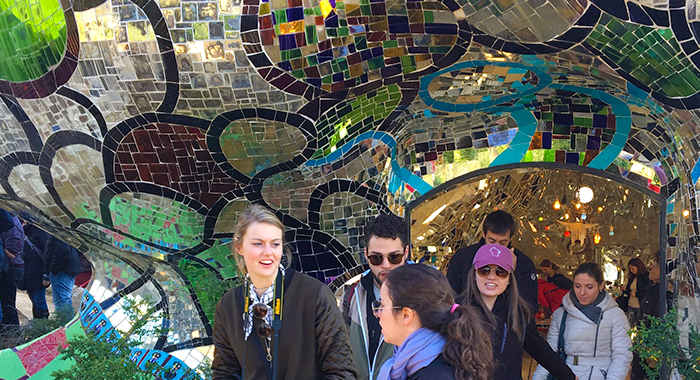J-Term Course Takes Art Students to the Eternal City
Imagine gazing at Michelangelo’s “The Creation of Adam” in the Sistine Chapel, or studying the intricacies of his “Pieta” at St. Peter’s Basilica, before heading to a nearby studio to create your own art based on your impression of those iconic works.
This is how 11 fortunate St. Norbert College students spent their recent J-term. For the first time, ceramicist Debbie Kupinsky (Art) led Rome and the Visual Arts, a new study-abroad class meant to help students gain an understanding of major artistic works, architecture and the traditions of Western art through site visits, readings, group discussions, creative work and blog posts.
The class returned from Italy on Jan. 19, and the experience proved so popular, Kupinsky intends to offer the course again.
“I was really pleased with the way it all went,” says Kupinsky. “I think it really helped the students to see the world beyond their community. Rome is a big city with narrow, cobblestone streets, lots of people and busy traffic. Just to see the layers of history is quite impressive. You see how they built buildings and structures incorporating ancient Roman columns. It really is impressive.”
Kupinsky organized the class through an Italian friend who owns an art studio in Rome. The studio served as a site where students could gather to discuss what they had seen earlier each day – the Roman Forum, Vatican City, the Sistine Chapel or the Borghese Gallery museum.
“Students were excited when we saw things that are iconic and that we all know,” she says. “When you see the Colosseum, they are impressed because it’s the Colosseum. The incredible history you see everywhere was a great learning experience for them. We went to see the oldest museum in Italy. The students saw art from Greece, the Renaissance, the Medieval period, and so much more.”
The class participated in several city walks to view Medieval churches, piazzas and fountains, and the Spanish Steps. They also had the opportunity to spend a day traveling to Pompeii by train.
Students did not need to be art majors to sign up for the program, as the idea behind the class was also to provide a broad cultural experience. “I had one girl who had never even been on an airplane,” Kupinsky notes.
Student blog posts reflect the excitement and appreciation the students felt.
“The visit as a whole to the Vatican didn’t really seem like going to another country, but another dimension,” writes Carla Davila ’19. “I mean, when I was going through security, I felt like I was climbing the stairs to Olympus. I was able to see something that very few people ever get to see and, quite frankly, for some irrational reason, I felt chosen. I mean, I was going to a place that is so sacred and respected by all religions and nations. And all I had to do was get my ticket.”
Seeing artwork such as the “Pieta” was amazing, she says in her blog post, “but the connection I made was spiritual because of the way the place made me feel, walking through a bigger-than-life building.”
For English major Caitlin McCauley ’19, visiting the “Mater Admirabilis” – a fresco of a serene and peaceful young Mary located at the Religious of the Sacred Heart Convent – was especially meaningful.
“This is an image I have grown up seeing nearly my whole life,” she writes in her blog. “I attended Sacred Heart schools in Chicago, where, like every Sacred Heart school across the world, each year we celebrated the feast day of Mater Admirabilis and retold the story of the fresco and how it came to be. Seeing the image in person was an incredibly moving and inspiring experience for me. I felt a sense of peace and a sacred aspect about the fresco, seeing the original in person. I think the soft colors in this fresco are what make Mary seem more accessible to the everyday person and why so many people across the world are captivated by this portrait.”
The experience provided other insights to bring back home, Kupinsky says. “The things we take for granted are seeped in history,” the ceramicist says. “When I look at something like a column, like even the columns on buildings at Lawrence University [in nearby Appleton, Wis.] I think, ‘Those are based on Roman columns.’ That shared past was really something I wanted the students to get from the class. To see the world as a bigger place.”
Feb. 6, 2018












